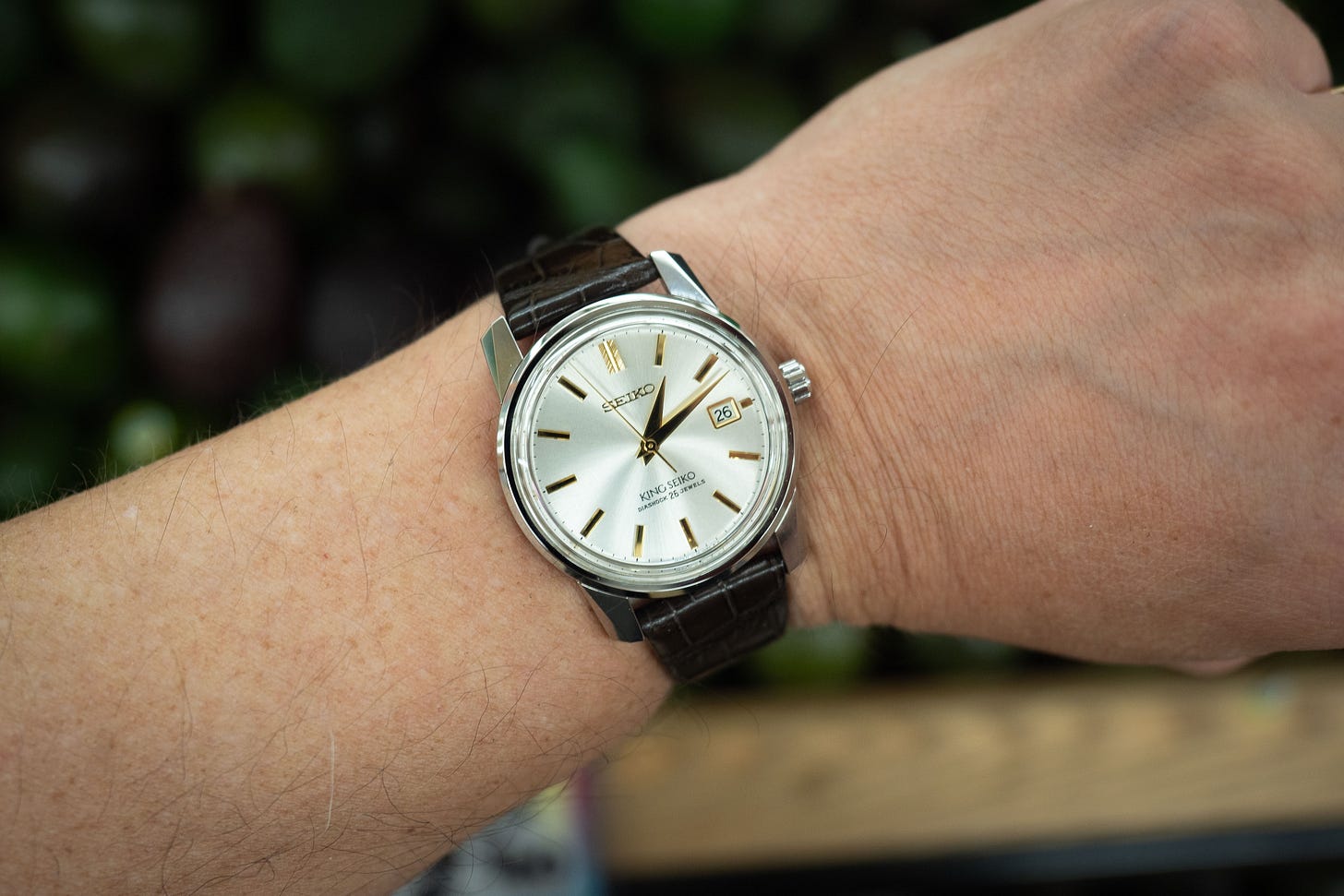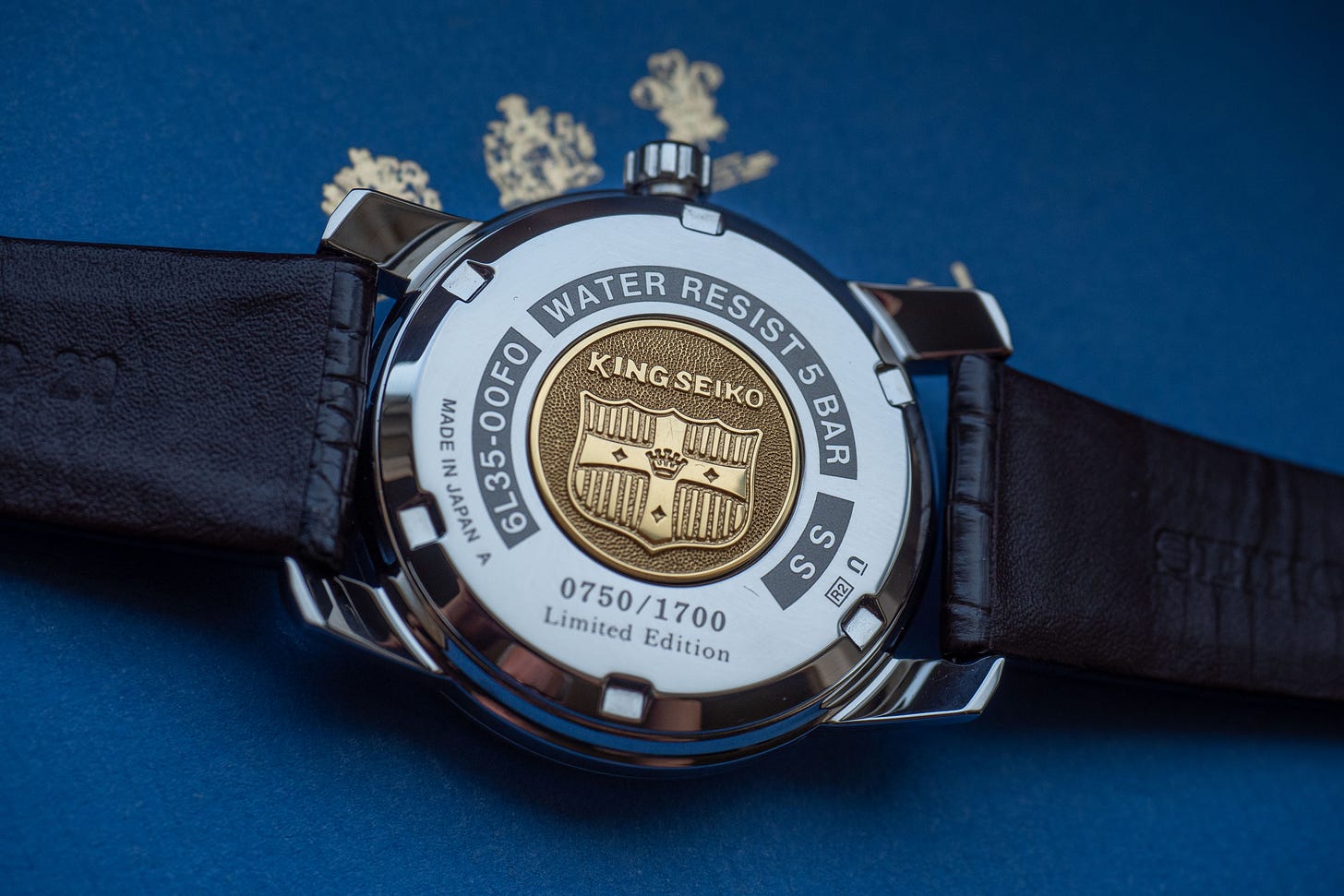The Once And Future King Seiko
The King 'KSK' Limited Edition SJE087 is a killer daily driver. But is it a real King Seiko?
Despite the long shadow thrown by the name, King Seiko was not around for all that long. The King Seiko watches were originally made from about 1961 to 1975, and they were, like Grand Seiko, meant to represent the highest end of home-grown Japanese watchmaking – timepieces that could compete head to head with precision chronometers from Switzerland. Both King Seiko and Grand Seiko have their collectors – a lot of the time, the same person, although Grand Seiko’s history and design heritage is obviously much better known. Both King and Grand Seiko kicked off at about the same time and both went dark at the same time – 1975 – but Grand Seiko for whatever reason was the name Seiko chose to resurrect as its flagship high end model in the 1980s and it’s stayed that way.
The Watch That Would Be King
King Seiko as the alternative to Grand Seiko in Seiko’s historical lineup, comes therefore with some historical baggage and the expectation that enthusiasts had, and have, of KS is that it will represent the same thing now that it did from its birth through the mid-1970s, which is reasonable – you bring an honored ancestor into the modern world and you will naturally expect it to walk the same walk and talk the same talk as it did in its first incarnation.
By now the new King Seiko watches have been out for long enough that both the pros and the cons relative to the originals and what they meant in the Seiko lineup, versus what we’re getting in the new King Seiko watches, have been widely discussed and though there is nothing like a consensus, several folks have said that while they find the aesthetics both effective nostalgically and compelling in the contemporary watch world, that they felt let down by the movement.
Before I get to that, however, there’s the question of the impression the King Seiko King 'KSK' Limited Edition SJE087 makes in the hand and on the wrist. It’s next to impossible to look at a watch as historically resonant as the King Seiko and not see it through the lens of expectations conditioned by history but I’m going to give it my best shot, albeit it’s probably a fool’s errand.
The King Seiko KSK LE is, by the numbers, about as classical an example of mid-1960s watchmaking as any retro-grouch, or for that matter, Gen-Z retro-nostalgist could possible want. The size is right at 38mm x 11.4mm, which is within a mil or two of the first King Seikos from the 1960s (J14102 was 35mm) and the sunray brushed dial immediately pulls you into the horological Wayback Machine, date set for 1962 (a somewhat arbitrary choice but it was the year I was born and maybe, given a working time machine instead of a metaphorical one, I’d head back and test out the ol’ Grandfather Paradox).
What you might not notice at first is just how good the casework and dial furniture are. The lugs by my count have a total of six different flat and polished surfaces and the faceting and crispness of the transitions can withstand a comparison with similar Grand Seiko cases. The dial furniture is also of exemplary quality – the hands are sharply beveled, indexes mirror polished, and the double index at 12:00 has a subtle but clearly visible cross-hatched pattern.
This is all by way of saying that absent the long shadow of the original King Seiko watches and the original KSK – whose shade, to be fair, has been invoked by Seiko itself – this feels like a very high quality watch. There is of course the matter of the movement (caliber 6L35) the debate about which I don’t mean to get into in any depth mostly because anyone who cares about chronometry is well aware of the original history of KS movements, relative to GS movements, and of the fact that the 6L35 is not quite the equal of some of the movements in Grand Seikos. Of course, the KSK is not a GS and the price reflects that. The KSK re-issue is $3,300 and as far as I can tell, the least expensive mechanical Grand Seiko is the very fine looking SBGR261 automatic, which as of this writing will set you back $4,300.
Evaluating a watch can be hard, because of course, what you’re doing is not so much evaluating the watch, as you are evaluating your feelings about the watch. Sometimes things are straightforward – physical dimensions, water resistance, shock resistance, and resistance to magnetic fields are all quantifiable. There are somewhat subjective aspects to a watch as well, which are nonetheless amenable to widespread consensus. Legibility is one of them – a traditional openworked ultra thin watch, with slim hands struggling to stand out against the baroque chaos of the movement, is never going to be anyone’s poster child for legibility.
As a general rule, with watches as with most things, we tend to respond emotionally, and then find reasons to justify those feelings after the fact, when our minds are already made up. There are pros and cons about the KSK SJE087, but my initial reaction was love – at first sight, you might say. I don’t really know why – I have a soft spot for this kind of watch design, which conveys quiet good quality without a lot of superfluous razzle-dazzle. When I put the KSK on for the first time, the first actual thought that came to mind was that this was one of a very small group of watches I could think of that would make a perfect, one watch collection, daily wear piece – good looking, from a real brand with real history, but not so precious or dear in terms of price that you’d balk at living with it on a daily basis.
And as for reasons for preferring it over something else, at a similar price point? That’s for everyone to decide for themselves. For me, I don’t feel the need to find reasons to like this watch as much as I do. Under such circumstances, we often say that there’s no arguing in matters of taste, but I like another saying which I think is more apt in this case – that the heart has its reasons, whereof reason knows nothing.





It’s worth noting that the 6L isn’t related to the infamous 6R found in the mass market SPBxxx King Seikos—the 6L is basically Seiko’s 2892 while the 6R is…whatever it is. That doesn’t mean that they’re “enough” for a King Seiko revival but it is a difference worth noting.
Ditch the gold medallion, replace KING with LORD.